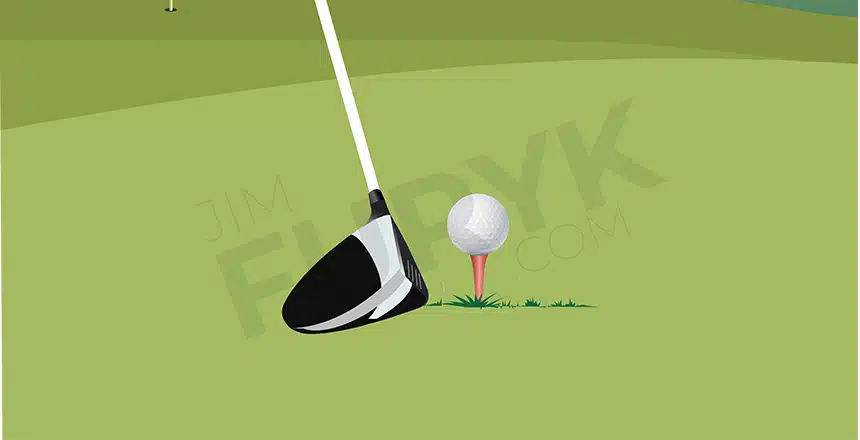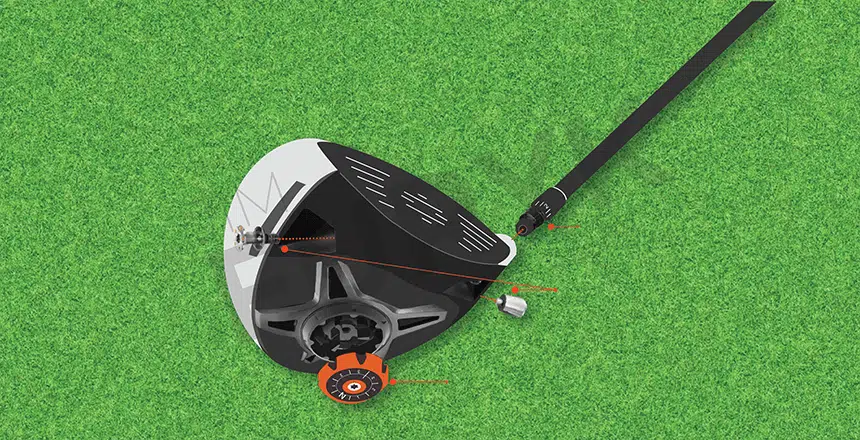To maximize your play, choosing a driver that’s adjustable is sensible in action. After all, adjustable golf drivers provide HUGE assistance in terms of distance from the very first shot itself off the tee. And then there’s also the most likely possibility of reducing the number of strokes off your round of golf.
But then what is this adjustability? Different adjustment settings are a part of this – adjustable hosel for changing loft angle and sliding weights for dialing in ball flight.
If you’re not acquainted with how it all works, you might find driver adjustability quite complex to understand. In that case, please keep reading…
In This Post
- Adjustable Drivers Explained – What Are They?
- Adjustable Driver – Types of Adjustability
- Adjustable Driver – Why Do You Need It?
- Adjustable Driver – Who Can Use It?
- Adjustable Driver – Who CAN’T Use It?
- Adjustable Driver – Is It More Expensive?
- Adjustable Driver – Features of An Adjustable Clubhead
- Adjustable Driver – How Can It Correct Swing Flaws?
- Adjustable Driver – What Are Its Disadvantages?
- How Does Adjusting Driver Loft Affect Face Angle?
- The End – So Then Is the Best Adjustable Golf Driver Worth Buying?
Adjustable Drivers Explained – What Are They?

It’s a golf driver that you can adjust with the help of a wrench. Changing or adjusting the driver this way means customizing it to get it to fit your style of play.
With adjustability, you can optimize crucial factors like ball flight, shot trajectory, etc. Along with matching the adjustable golf club to the hole you’re playing or to the course. Or simply to your game as it progresses!
As for what is the feature that’s adjustable in a golf driver? This adjustability takes the form of either an adjustable hosel or movable/sliding weights. The former consists of lie angle and loft angle settings. And the latter, slightly more advanced adjustability, involves changing the center of gravity for anti-slice or anti-hook performance.
Also, the grip and shaft of these types of drivers are not adjustable. Once again, they are not the adjustable parts of the golf club.
Adjustable Driver – Types of Adjustability
One is an adjustable hosel and the other is movable weights.
Each type offers its own set of benefits when it comes to boosting swing performance on the golf course. For example, for a lower or higher ball flight, adjusting the driver loft makes more sense while correcting the right or left course or path or trajectory of your shot requires adjusting weight positions.
Golf Driver with Adjustable Hosel
An adjustable hosel means you can increase or decrease the loft angle in order to fix an excessively low or excessively high ball flight. When you raise the loft, you’re closing the clubface slightly more. And when you lower it, you’re opening the clubface a little more. Here’s golf club loft angle explained.
What about lie angle adjustability? Increasing this creates fade bias while decreasing it produces draw bias.
Golf Driver with Adjustable or Movable or Sliding Weights
The weights refer to the center of gravity of the golf club, which you can move either forward or back. Moving the weights also results in optimizing ball flight – back CG weighting will increase launch angle to increase ball flight and also the carry distance while sliding the weights forward equals lower launch, more piercing ball flight, and greater rollout.
And then another way to go about it with some drivers is to move the weights toward the toe (fade bias) or heel (draw bias) of the golf club.
Adjustable Driver – Why Do You Need It?
Driver adjustability comes in handy at a time when that consistent miss becomes a part of your off-the-tee performance. With adjustable weights, you can correct consistent right or left misses. Along with fixing a too low or too high ball flight (via loft angle adjustability).
So if you’re looking to correct a consistent off-the-tee miss, adjustable driver technology is FOR YOU!
Adjustable Driver – Who Can Use It?
If you want my personal take on this, then I think that every golfer out there is going to get something good out of an adjustable driver. But I also believe that those struggling with consistent misses off the tee benefit MORE.
For fixing a slice, adjustable weights can be moved more toward the heel, which automatically generates a draw-biased, thus straighter ball flight. While correcting a hook requires you to shift the weights toward the toe for a more fade-biased approach.
Golfers often hitting their shots too low or too high also prefer their drivers to come with the adjustability, especially an adjustable hosel. Because raising the loft angle on that hosel takes the ball flight higher (this explains why golf drivers for seniors are adjustable) while lowering it helps when you’re simply just ballooning your shots off the tee.
Adjustable Driver – Who CAN’T Use It?
Once again, almost every player will benefit from a golf driver that’s adjustable. But then there are those very few who might not find it easy to work with or use this adjustability. And those very few are golfers with an ‘extremely slow’ swing speed.
When your swing speed is that low, it means you struggle to swing a heavy club. Hence, it’s so important, at such times, to hit a more lightweight driver (which, more often than not, is a non-adjustable one). An easier-to-hit driver is indeed the best for slower swing speeds. These golf drivers are highly forgiving and lightweight with a lower CG by default.
Adjustable Driver – Is It More Expensive?
In comparison to standard or regular drivers, adjustable drivers are NOT more expensive. But that’s what it has come to now. Back when adjustable driver technology was first launched, the latter was priced slightly higher than the former. However, that’s not the case today with modern golf because of the greater demand and supply.
Adjustable Driver – Features of An Adjustable Clubhead
- Loft and Lie Angle
Adjustable hosel drivers allow you to change the loft or lie angle.
Adjusting the loft will lower or increase ball flight while adjusting the lie or face angle either slightly opens or closes the clubface at impact.
- Clubhead Weights
Driver weighting can fix your slices and hooks. Or it can be adjusted to give you less or more spin.
Adjustable Driver – How Can It Correct Swing Flaws?

The whole physics of driver adjustability is all about fixing golf swing flaws, which is why beginners and even average golfers prefer using adjustable drivers. Having sliding weights and adjustable hosels at your disposal can really correct ball flight. And it’s the same reason why many of Callaway’s drivers, TaylorMade’s drivers, and many more are adjustable.
- TOO HIGH BALL FLIGHT
You know you have a swing flaw when you’re launching the golf ball too high. This means the angle of attack is excessively upward, which adds spin and loft. And that’s how you lose carry distance plus even the ball doesn’t roll properly after it lands.
So the solution here is using an adjustable driver with a lower loft. Through hosel adjustability, decrease the loft angle to 8.5 degrees in order to slightly lower the launch angle. The outcome of which is flatter trajectory, more efficient carry, and more energy-packed landing angle with more roll.
- TOO LOW BALL FLIGHT
You’re supposed to be generating that perfect downward blow to produce greater ball-flight-increasing backspin. But hitting down like this is no good when the driver isn’t high-lofted too. Surprisingly, even fast-swingers in golf increase the loft angle because drivers these days don’t launch with enough spin.
The solution then is adding loft. More specifically, increasing the loft to 11.5 degrees to boost carry distance.
- SLICE
When the face of the driver is open, it’s only inevitable for your shots to begin toward the right. An overly high launch angle can also be produced, which takes the ball even more to the right.
So how about closing that clubface a little? This means shifting the movable weights of the driver clubhead toward its heel. With a more closed face, shots will then launch straighter on their own. And as the clubface closes more readily, you get greater draw-spin as well.
- HOOK
Now, this swing flaw is an outcome of the clubface being closed to that path of swing.
In such scenarios, you need to adjust the sliding weights toward the toe to slightly open the face. The same result can also be created by lowering the loft angle.
Adjustable Driver – What Are Its Disadvantages?
Heavier Weight
With adjustable settings (i.e. screws and adjustable hosel), the golf driver becomes slightly heavier. And this additional weight on the clubhead will be felt if your swing speed is already very slow.
So, if you can relate, choose a driver with fixed weight and loft but with a lower center of gravity to boost your performance.
Overthinking the Effect of Adjustments
Another very common drawback to using an adjustable loft driver is that your mind is likely to get too hung up on what impact those adjustments will have. This includes overestimating the importance of even half a degree of loft angle.
How Does Adjusting Driver Loft Affect Face Angle?
The clubface angle is the loft. So when you lower the loft, you’re also reducing (closing) the face angle. Likewise, when you increase the loft, you’re also increasing the angle of the clubface (meaning open face angle).
For a higher ball flight, you add loft to increase/open the face angle. While lowering the ball flight requires you to decrease loft and face angle i.e. close the clubface.
The loft angle of the golf club has an impact on the direction as well as spin rate of the ball, which influences the distance it travels. Higher loft is equal to higher ball flight plus greater rotation. While lower loft gives you lower ball flight with less spin.
Also keep in mind that excessive golf ball spin inflates up your shot in the air, thus minimizing distance. On the other hand, too little spin means the ball loses its stopping power on grass.
The End – So Then Is the Best Adjustable Golf Driver Worth Buying?
You now know how it works and what are its many benefits and very few drawbacks. So based on YOUR performance, you can decide if buying one is going to benefit your game or not.
And if you’re worried about the cost, then let me bring to your attention that there are the best cheap adjustable drivers as well. Because adjustable driver technology is now no more as expensive as it used to be when it was first released in the golf market.
Fortunately, there are plenty of lower-priced ‘adjustable’ drivers that are fully equipped to correct your consistent swing faults.


I love how you explain in detail the golf basics.
One thing you fail to mention is a tendency, primarily by amateurs, to change lofts, lie angles, etc. too often. That has been my problem. I’ve probably tried every setting on my Tour Edge EXS 220 driver. Currently, I’m at 7.5* with a 58* lie angle. Seems odd for a 70 year old with about 85 mph swing speed? Before my change, I was at 9.5* with 60* lie angle.
Wanna bet when I go back after the off season, it’ll be something different?
If I ever get a new driver, I’ll probably get a swing analysis, purchase a Tour Edge driver with no adjustment and enjoy the lighter weight and price tag. Oh, did I mention I’m a Tour Edge guy?